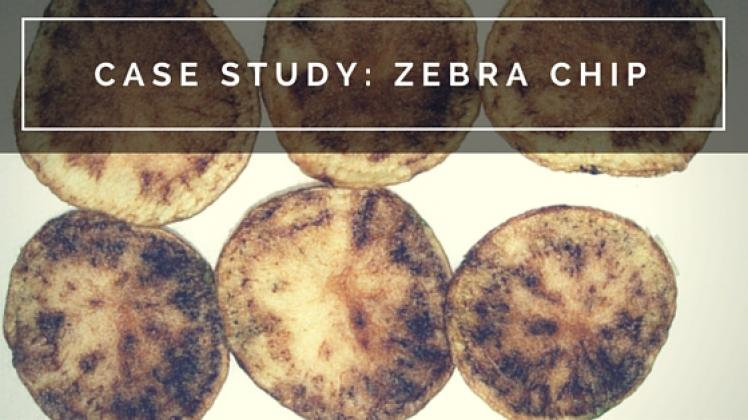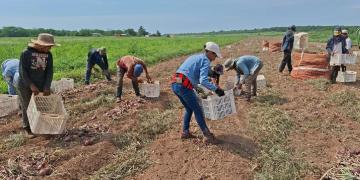Australia: Case Study: Zebra chip
Zebra chip disease of potato is caused by the bacterium Candidatus Liberibacter solanacearum (CLso). This pathogen is vectored by the tomato potato psyllid (TPP; Bactericera cockerelli) and can also be spread via infected seed potato.
The characteristic symptom of zebra chip is an alternating pattern of dark and light bands in fried potato slices. This symptom is variable, including the intensity of the colour difference, the delineation of edges of the bands and distinct regular banding versus irregular mottling across the slice. There are a range of symptoms on the leaves and stems of the plants including aerial tubers, thickened internodes, yellowing and leaf cupping - none are definitive for the presence of CLso in the plant.
This disease has resulted in significant economic losses in both New Zealand and the United States. It has been reported that the psyllid alone caused production losses to New Zealand producers of NZD$43 million in 2008/2009(footnote 1.). Currently total losses and psyllid control costs are estimated to be NZD$200 million since 2008.
Australia is a centre of psyllid diversity with approximately 600 species, representing approximately 30 per cent of the worlds estimated psyllid species. In 2014 both TPP and CLso were found on Norfolk Island. The pathway of entry to Norfolk Island is unknown.
Potatoes are the largest vegetable industry in Australia with an annual value of approximately AUD$690 million (ABARES 12/13). Approximately 56 per cent of the crop is processed (mainly French fries and crisps), 36 per cent is sold on the fresh market (as potatoes) and 8 per cent used as seed.
CLso infects a wide range of solanaceous plants including tomato, capsicum and tamarillo. The bacterium has been recently reported as infecting the apiaceous plants carrot and celery in Europe and Scandinavia. The current diagnostic protocol is based on one region of the bacterial genome of one of the potato-infecting variants: differentiating the solanaceous and apiaceous infecting variants requires additional testing.
In New approaches for diagnostic pathovars, an improved diagnostic protocol for CLso is being developed based on understanding the genetic diversity in all the variants of this pathogen. It is being developed via detailed bioinformatic analyses of the genomes of a range of the solanaceous and apiaceous infecting CLso variants. Once validated, the updated protocol will benefit Australia by improving our confidence that this pathogen can be quickly and specifically identified.
This diagnostic will reduce the probability of benign endemic sub-species triggering unfounded limitations on trade that would later need to be unwound.
The new protocol will help to quickly identify which biological type is present and will deliver three or more sensitive diagnostic tools to increase scope and accuracy of the diagnostic. It is also hoped that the diagnostic will better inform the understanding of the origin and pathway used for Liberibacter solanacearum to establish in New Zealand.
1. Plant Health Australia, Industry Biosecurity Plan for the Potato industry
Australia is a centre of psyllid diversity, so to improve the accuracy of the Candidatus Liberibacter solanacearum (CLso) diagnostic within an Australian environment, PBCRC PhD candidate Jacqueline Morris is investigating the native microflora in three endemic species of psyllids to determine whether the Liberibacter genera is present. The outputs of this work will contribute to improving the accuracy of the diagnostics being used in Australia by reducing the potential for the diagnostic to detect benign endemic Liberibacter species. Listen to Jacqui talk about her research on the Biosecurity built on science podcast.
Fuente: http://www.pbcrc.com.au/news/2016/pbcrc/case-study-zebra-chip





